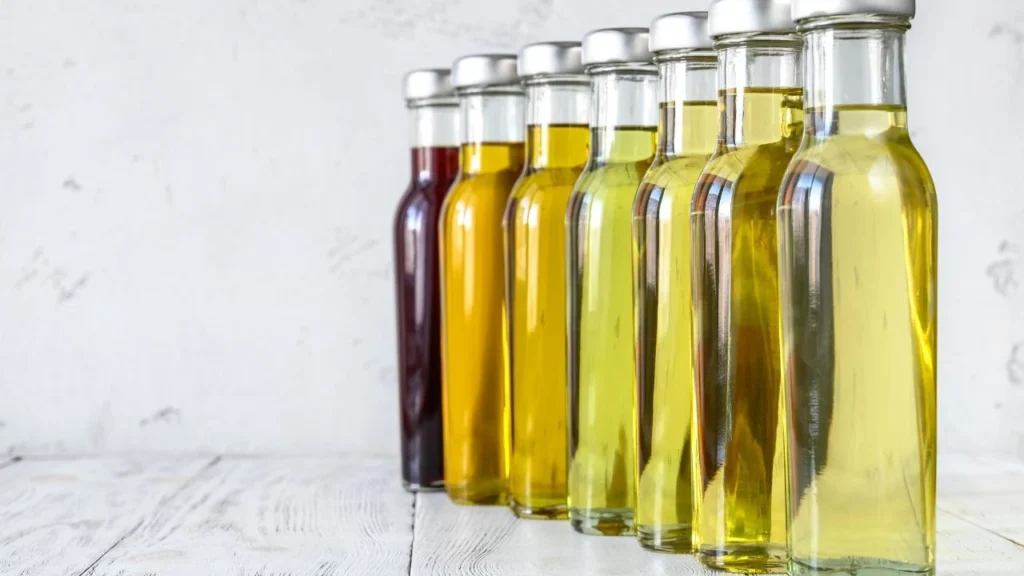Picking the right frying oil can be the difference between a golden, delicious success and a greasy disaster. The oil you use doesn’t just impact taste—it influences your food’s texture, health factor, and even how evenly it cooks. Let’s explore the different frying oils, their unique traits, flavor profiles, and health benefits. By the end, you’ll know the best oil for a fryer to make your next fried dish shine.
Importance of Choosing the Right Oil for Frying
Selecting the ideal frying oil is vital for any kitchen. It affects food quality, taste, and health. Several key factors should guide your oil choice.
Smoke Point Matters
Smoke point is crucial when picking frying oil. It’s when oil starts to break down and smoke. High-heat frying needs oils with high smoke points.
Extra virgin olive oil has a low smoke point of 320°F. This makes it unsuitable for deep frying.
Flavor Impact of Frying Oils
Different oils affect food flavor differently. Canola oil has a neutral taste and low saturated fat content. Peanut oil adds a distinct flavor and has a high smoke point of 450°F.
Health Considerations
Health is a key factor in choosing frying oil. Avocado oil is healthy with a 520°F smoke point, but it’s expensive.
Blended vegetable oils offer health benefits and affordability. Their smoke points range from 400-450°F, making them versatile for commercial kitchens.
Proper oil management extends its life and maintains food quality. Regular filtering and temperature control can reduce costs in busy kitchens.
Understanding Smoke Points

Smoke points are vital in deep-frying. It’s the temperature where oil breaks down and smokes. This affects your food’s cooking and taste.
What is Smoke Point?
Smoke points vary from 250°F to over 500°F for different oils. Refined oils typically have higher smoke points than unrefined ones.
Extra virgin olive oil’s smoke point is 325-400°F. Light olive oil reaches 465°F.
Importance of Smoke Point in Frying
Using oil past its smoke point can spoil your food. It can also create harmful compounds. Choosing the right oil for high-temperature cooking is crucial.
Impact on Cooking Results
The right oil helps achieve crispy, golden-brown food. Peanut (420-430°F), sunflower (440-450°F), and avocado (480-520°F) oils handle high temperatures well.
High Smoke Point Oils
- Avocado oil: 480-520°F
- Safflower oil: 510°F
- Rice bran oil: 490°F
- Peanut oil: 420-430°F
- Sunflower oil: 440-450°F
These oils withstand intense heat without breaking down. They ensure your food cooks perfectly every time.
Types of Oils for Frying

The right oil can make your fried foods taste amazing. Look for oils with high smoke points for deep frying. These oils can handle the intense heat needed for crispy results.
Vegetable Oils
Vegetable oil is a top pick for deep frying. Its smoke point ranges from 400°F to 450°F, perfect for high-heat cooking. This affordable oil has a neutral taste that won’t alter your food’s flavor.
Popular Options: Corn Oil and Soybean Oil
Corn and soybean oils excel in deep frying. Both have a 450°F smoke point and are budget-friendly. These oils are common in commercial kitchens due to their availability.
You can reuse them multiple times if you strain and store them properly.
Peanut Oil
Peanut oil is a stellar choice for deep fryers. It has a high 450°F smoke point and adds a mild nutty flavor. This oil creates crispy textures and enhances rich flavors in dishes.
- Smoke point: 450°F
- Flavor: Subtle, nutty
- Best for: Deep frying, especially for dishes where a slight nutty taste is desired
Always watch your deep fryer’s temperature, no matter which oil you use. The right heat ensures your food turns out crispy and delicious every time.
Health Considerations

Choosing a healthier frying oil impacts your cooking and well-being. The right oil can make a big difference in your meals. Consider its nutritional value and heart health effects.
Nutritional Content
Olive and avocado oils are high in monounsaturated fats. These heart-healthy oils stay stable at high temperatures. Olive oil, with a 410°F smoke point, is great for health-conscious cooks.
Oils for Heart Health
Avocado, olive, and peanut oils may reduce insulin resistance better than saturated fats. Their stable carbon bonds make them less likely to oxidize during frying. Try to keep saturated fat intake to 5-6% of total calories.
Avoiding Harmful Trans Fats
Avoid soybean or corn oil for deep frying. These oils can oxidize at high temperatures. Instead, use avocado oil (520°F) or peanut oil (446°F) for frying.
These oils have higher smoke points. They help reduce harmful compounds during frying.
- Use fresh oil for each frying session to prevent oxidation
- Keep frying temperatures between 350-375°F for best results
- Consider grass-fed butter or ghee for added nutrients and antioxidants
Flavor Profiles

Frying oils significantly impact your dish’s taste. The right oil can make your fried creations shine. Let’s explore how oil flavors affect your cooking.
Neutral vs. Distinctive Flavors
Neutral-tasting oils are kitchen essentials. They don’t add their own flavor, letting your food’s taste stand out. Canola, vegetable, and refined olive oils are great for all-purpose frying.
Distinctive oil flavors can enhance your dishes. Peanut oil adds subtle nuttiness, while avocado oil offers a mild, buttery taste. These unique flavors can elevate recipes, adding depth and complexity.
Matching Oil Flavor to Food
Pairing the right oil with your food is crucial. For delicate flavors, use neutral oils to avoid overpowering your dish. When adding flavor, choose oils with distinctive tastes.
Peanut oil enhances Asian-inspired dishes, while avocado oil complements Mexican cuisine. Experiment to find the perfect match for your culinary creations.
- Neutral oils: Best for versatile use
- Peanut oil: Great for stir-fries and deep-frying
- Avocado oil: Perfect for high-heat cooking and adding subtle flavor
The oil you choose can greatly impact your fried foods. Try different options to discover your favorite combinations.
Final Thoughts on the Best Oil for a Fryer
Choosing the best oil for a fryer is vital for commercial fryers. Vegetable oil is popular due to its versatility and affordability. Canola oil offers a healthier option with lower saturated fat.
Peanut oil has a high smoke point of 450°F and adds a nutty flavor. However, it may cause allergic reactions. Sunflower oil, with its 440°F smoke point, is gaining popularity in commercial kitchens.
- Smoke point (aim for 400°F or higher)
- Flavor impact on food
- Health benefits
- Cost-effectiveness
- Potential allergens
Proper oil management is crucial for frying efficiency. Monitor temperature and filter oil regularly. Dispose of used oil correctly to maintain quality. Today, there are also many modern solutions to enhance frying processes, such as specialized commercial fryers, advanced filters, or frylow, which help extend oil life and improve food quality.
By selecting the right oil and following best practices, you’ll achieve great results. Your commercial fryer will produce tasty food while considering health factors.
Recap of key considerations for selecting the best oil for frying
Choosing the right oil is crucial for optimal frying results. Consider the smoke point, flavor profile, and health aspects. Oils with high smoke points, above 400°F, are ideal for deep frying.
Peanut oil, with a smoke point of 425-450°F, is excellent for high-heat cooking. It can add a nutty taste to your fried foods.
Balancing Flavor and Versatility
Neutral-tasting oils like canola or soybean offer versatility across various dishes. Canola oil has a smoke point of 350-400°F. It provides a good balance of health benefits and affordability.
Health and Cost Considerations
Prioritize oils high in monounsaturated fats for better heart health. Avocado oil, with its 520°F smoke point, is a great option.
For commercial kitchens, consider cost-effective choices like vegetable oil blends. These have smoke points from 400-450°F and offer good performance and affordability.
Proper oil maintenance extends its life and ensures food safety. In busy restaurants, change fryer oil once or twice a week.
Following these guidelines will help you achieve consistent, high-quality fried foods. You’ll also manage costs effectively in your kitchen.
FAQ
What is the best oil to use in a deep fryer?
Oils with higher smoke points are ideal for deep frying because they can withstand higher temperatures without burning. Some common oils with high smoke points include peanut oil, canola oil, and safflower oil. These oils are suitable for high-heat cooking and provide a crispy texture to fried foods. For more details, see this guide to the best oils for deep frying.
What oil should you not fry with?
Oils to avoid for frying include soybean, corn, canola, sunflower, and safflower oils, as these contain unstable fats that may lose their nutritional properties under high heat. Additionally, using these oils may increase health risks. For more information, refer to which oils to avoid when frying.
What oil lasts the longest in a deep fryer?
Oils that tend to last the longest in a deep fryer are those high in saturated fats, such as peanut oil, vegetable shortening, or lard. These oils offer extended lifespan and yield the crispiest results. Learn more about oils that last in deep fryers and how to choose them for longevity.
What are the healthiest oils to use in a fryer?
Some of the healthiest oils to use in a fryer include avocado oil, olive oil, and canola oil due to their high smoke points and beneficial fatty acid profiles. Avocado oil and olive oil are rich in monounsaturated fats, which are heart-healthy, while canola oil offers a good balance of omega-3 and omega-6 fatty acids. Choosing refined oils with high smoke points can help ensure stability at high frying temperatures, making them a healthier option for frying.
How does the smoke point of an oil affect frying?
The smoke point of an oil is the temperature at which it begins to smoke and break down, impacting the flavor and safety of fried foods. Oils with higher smoke points are better suited for frying, as they can handle higher temperatures without degrading. This helps achieve optimal taste and crispiness while preventing burnt or off flavors. Selecting an oil with a suitable smoke point is essential for successful frying results.








